Behind the fins with Cassandra Ruck
Project leader, Cassandra Ruck was recently interviewed by The Fins United Initiative, we loved the blog so much, we decided to share it on her SOSF project page for you to find out a little more about her.
‘It’s no secret that Melissa (The Fins United Initiative founder) was lucky enough to work with great white sharks at Mossel Bay in South Africa a few years ago. She left with so many memories – including becoming good friends with a fellow American. Cassandra and Melissa worked with an array sharks (mainly great whites and pyjama sharks) while down there. ‘White sharks are absolutely incredible,’ Cassandra says. ‘They’re really curious and inquisitive creatures, but also extremely cautious. They don’t want to expend unnecessary energy and often make multiple passes around the boat and the bait to assess the situation. They are not monstrous killing machines. They are highly calculated top predators, and quite beautiful.’ We couldn’t agree more. We’re pleased to announce that Cassandra, a research assistant at the Save Our Seas Shark Research Center (USA), was featured as a ‘Behind the Fins’ scientist. She is currently studying for her Master’s at Nova Southeastern University and works with the Guy Harvey Research Institute. She’s got a lot going on – and we can’t wait to tell you all about it.
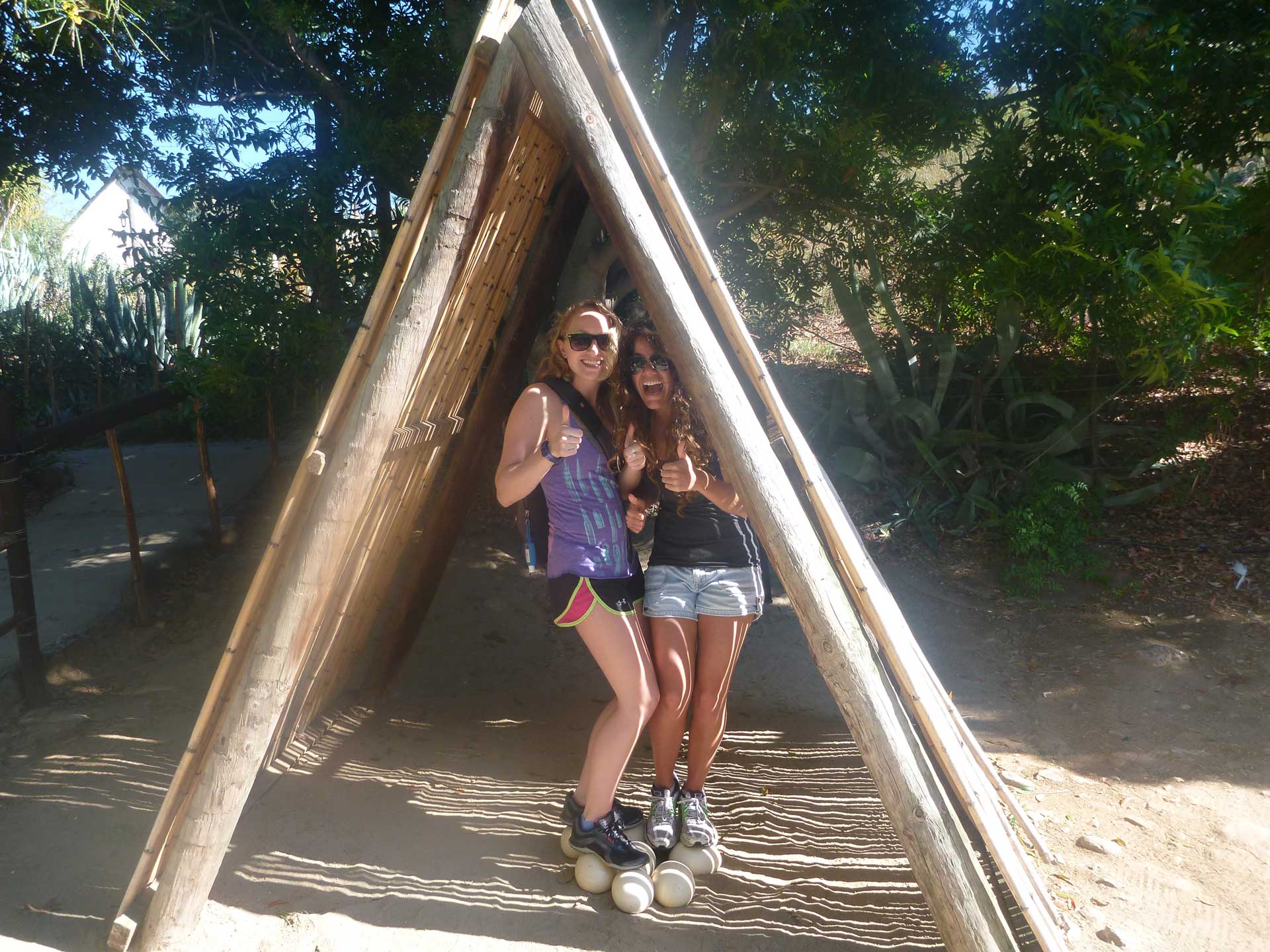
Cassandra Ruck and The Fins United Initiative Founder, Melissa Rooks, stand atop of ostrich eggs at an ostrich farm in Outdshoorn, South Africa.
The Fins United Initiative: What is your current research project?
Cassandra Ruck: I am working on my Master’s thesis, which focuses on the population genetics of the oceanic whitetip shark Carcharhinus longimanus. The oceanic whitetip is a globally distributed pelagic (open-ocean) shark species that has unfortunately suffered drastic declines due to heavy exploitation and by-catch rates. However, scientific publications on this species have been limited and no population genetic studies have been published to date.
[Update: Cassandra has since graduated and started working on her PhD, and there has since been a publication on oceanic whitetip population genetics. Camargo et al. 2016 came out with a mitochondrial control region study on the oceanic whitetip a few weeks ago, you can find it here.]
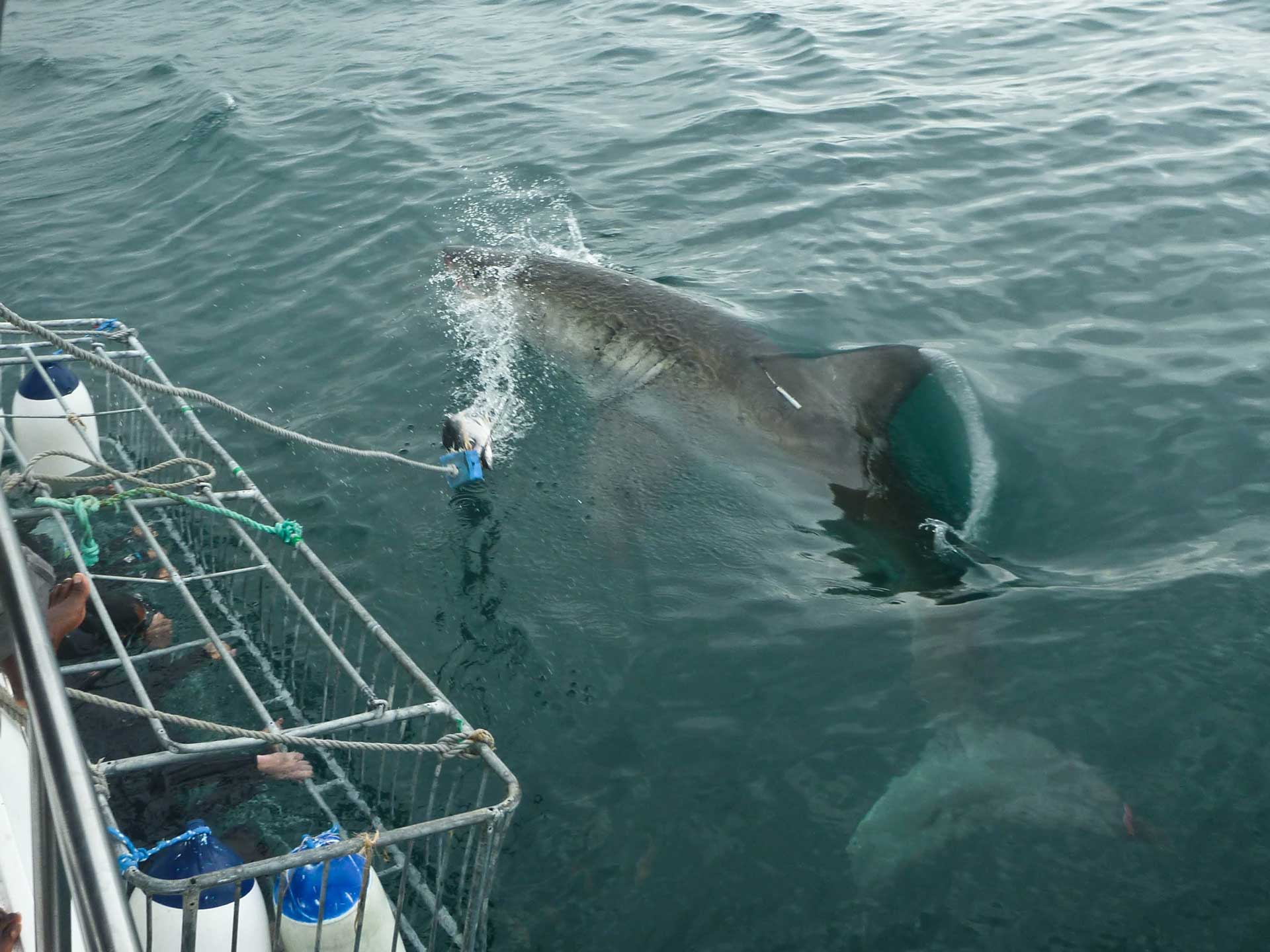
The first white shark seen by Cassie while cage diving in Mossel Bay. The shark was approximately 3.5 meters and is seen in comparison to the 3 meter cage.
TFUI: Sounds interesting. Can you tell us a little more?
CR: Of course! By extracting DNA from samples of these sharks taken from all around the globe, I will be able to provide a more holistic picture of what oceanic whitetips are really doing and take a look into the structure of the population (or stock, if you’re a fisheries person). This information is absolutely key for good, scientifically based management strategies. For example, if the sharks in the northern Atlantic are migrating and breeding with the sharks in the southern Atlantic, then these sharks should be considered as one population and need to be managed via an international cooperative strategy. That is, if the sharks belong to one population, overexploitation of them in the north will directly impact the genetic health of the sharks in the south (and vice versa). If, on the other hand, the sharks in the northern Atlantic are genetically distinct from those in the southern Atlantic, then separate management strategies must be implemented.

Cassandra holds a puffadder shyshark caught on a rod and reel for benthic shark studies at the Shark Lab Aquarium in Mossel Bay. Photo by Katherine Seger.
TFUI: That’s a great information nugget to point out. Assessing the health of shark populations via genetics is very important.
CR: Absolutely! And when you’re assessing the health of shark populations by means of genetic studies, genetic diversity is also very important. If a population has a high genetic diversity, it has a greater chance of surviving a large selection event (for example, ocean acidification, ocean warming, loss of prey availability or a change of prey species). This is because some of the individuals in the population may have specific genes (actually, genetically speaking they have specific alleles, but for our purposes we will refer to them as genes) that will help them to survive a drastic event and therefore keep the population going. However, if a population has low genetic diversity, the chances that a portion of the population will survive a selection event are much, much lower. Low genetic diversity also comes with the risk of inbreeding. Just like in humans and other animals, inbreeding can lead to negative effects in future generations.
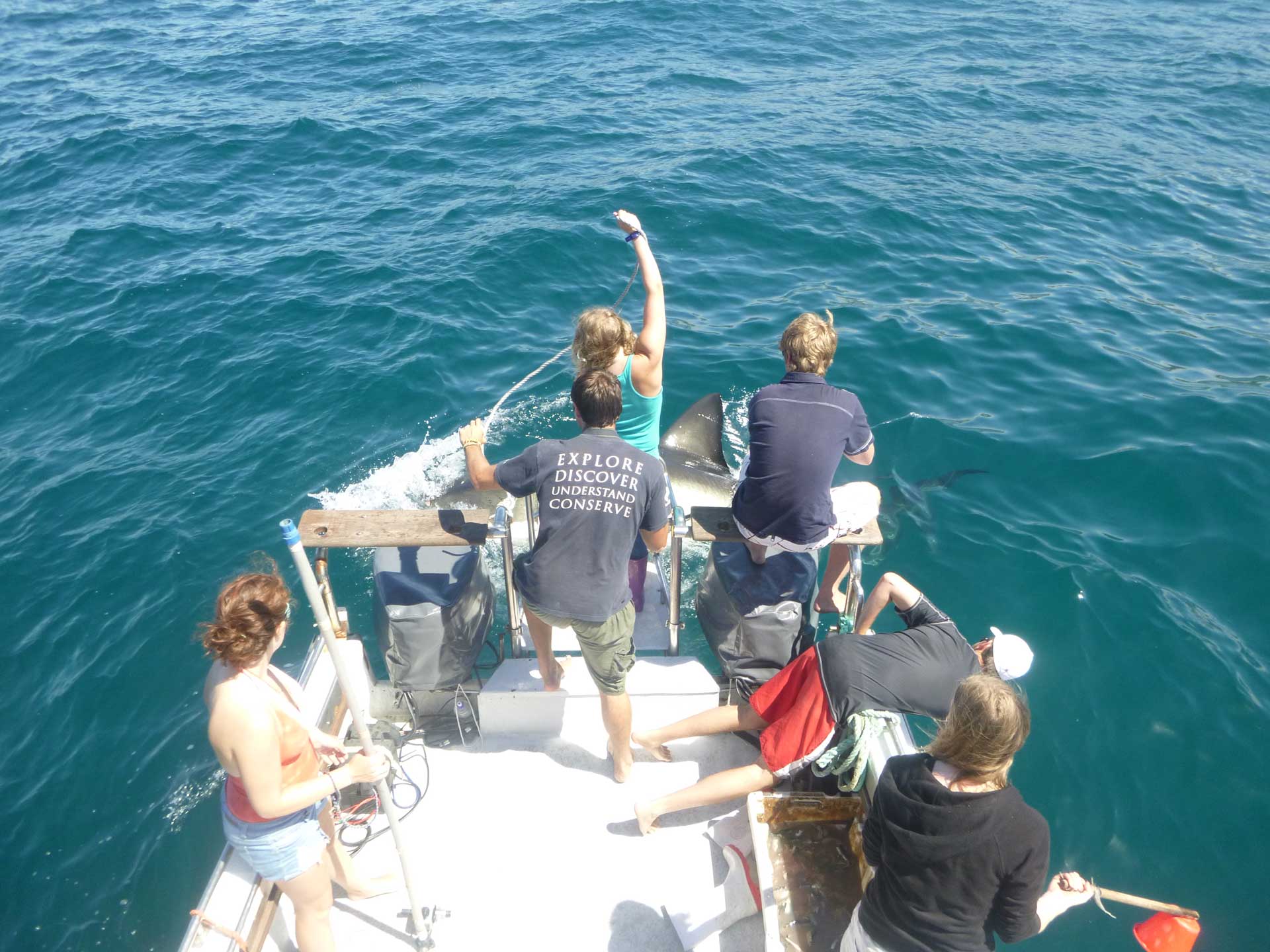
Cassandra plays keep away with a tuna head and a white shark in Mossel Bay, South Africa.
TFUI: Genetics is definitely an interesting topic to study – we envy what you’re doing and wish you the very best! We can’t wait for all the updates in your project further down the line.
CR: I hope that wasn’t too much information. I have invested quite a bit of myself into this project so I can talk about it for days! [laughs]
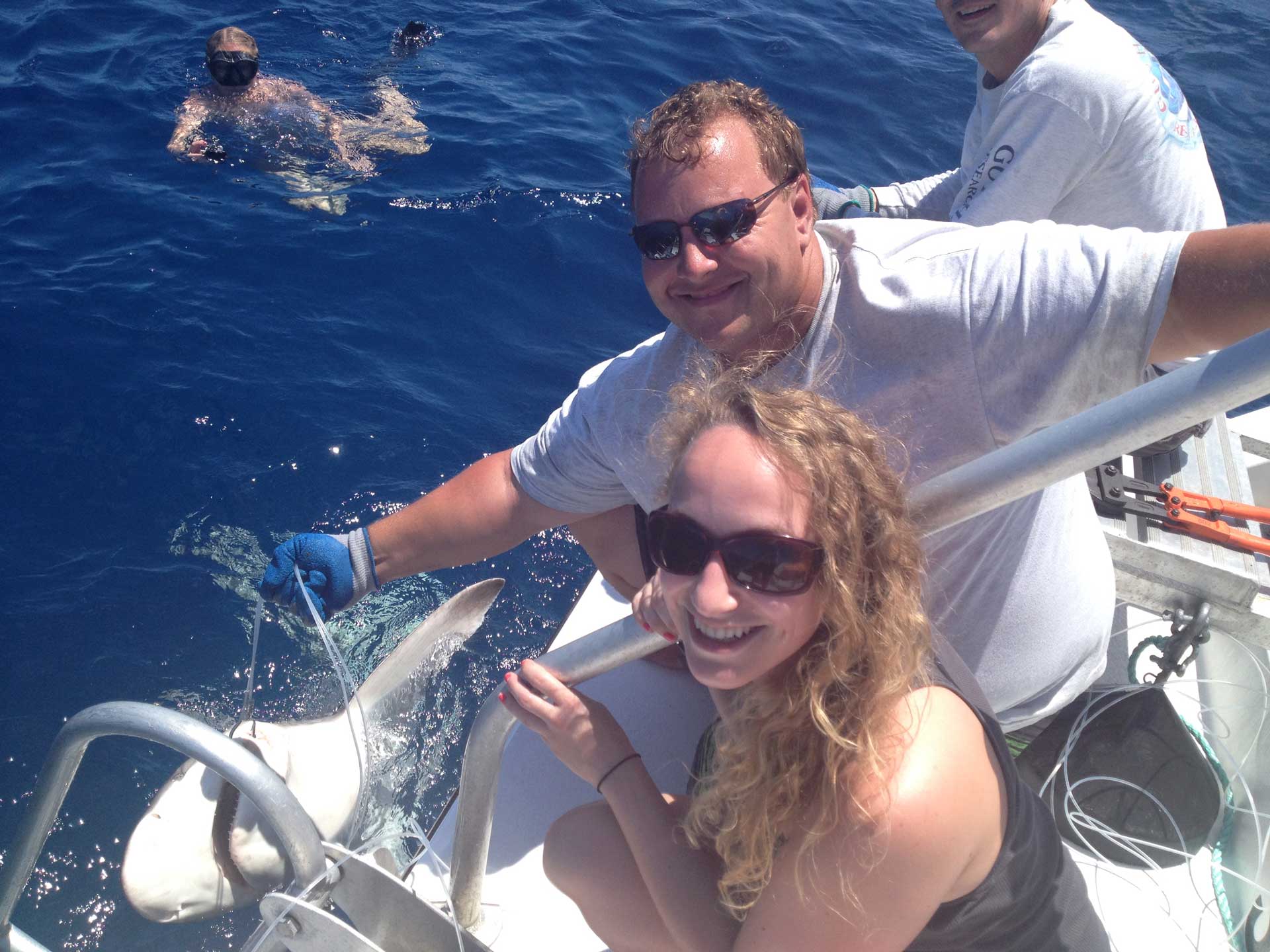
Cassandra with Dr. Derek Burkholder with a sandbar shark, caught in Dania Beach, FL. Photo © Guy Harvey Research Institute.
TFUI: [laughs] No, don’t apologise! We like that sort of enthusiasm – it’s what makes science fun! Please never lose it. What’s your dream research or conservation project?
CR: Wow, that’s a tough one. In an ideal world, I would love to be able to divide my time evenly between outreach, field work and doing analysis work in the laboratory. I think outreach is by far the most important thing when it comes to conservation (which is one of the reasons I think your blog is so awesome!). It is absolutely imperative for scientists to be able to communicate the importance of their work to the public, especially to the kids who will become the next generation of scientists and conservationists.
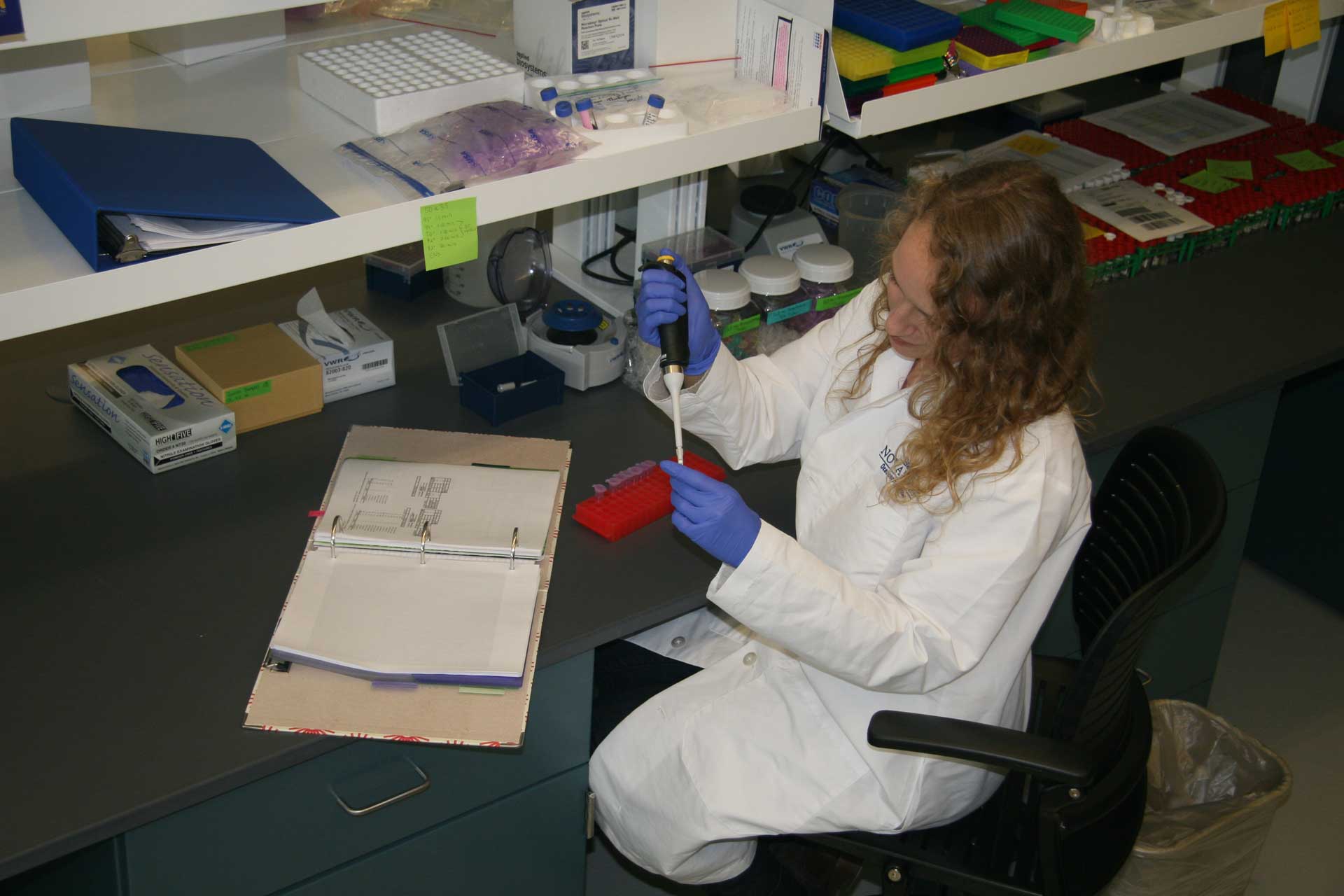
Conducting genetic lab work at the SOSSRC. Photo by Christine Testerman | © Save Our Seas Foundation
TFUI: We completely agree with you that outreach is an important aspect of conservation. In fact, all parts of the equation (the research, the analysis and publications, the outreach) play a vital role in conservation. We’re excited to see where you and others of the future take the marine science world next.
CR: Thanks! I would love to eventually run my own research group. But before that, I need my PhD!
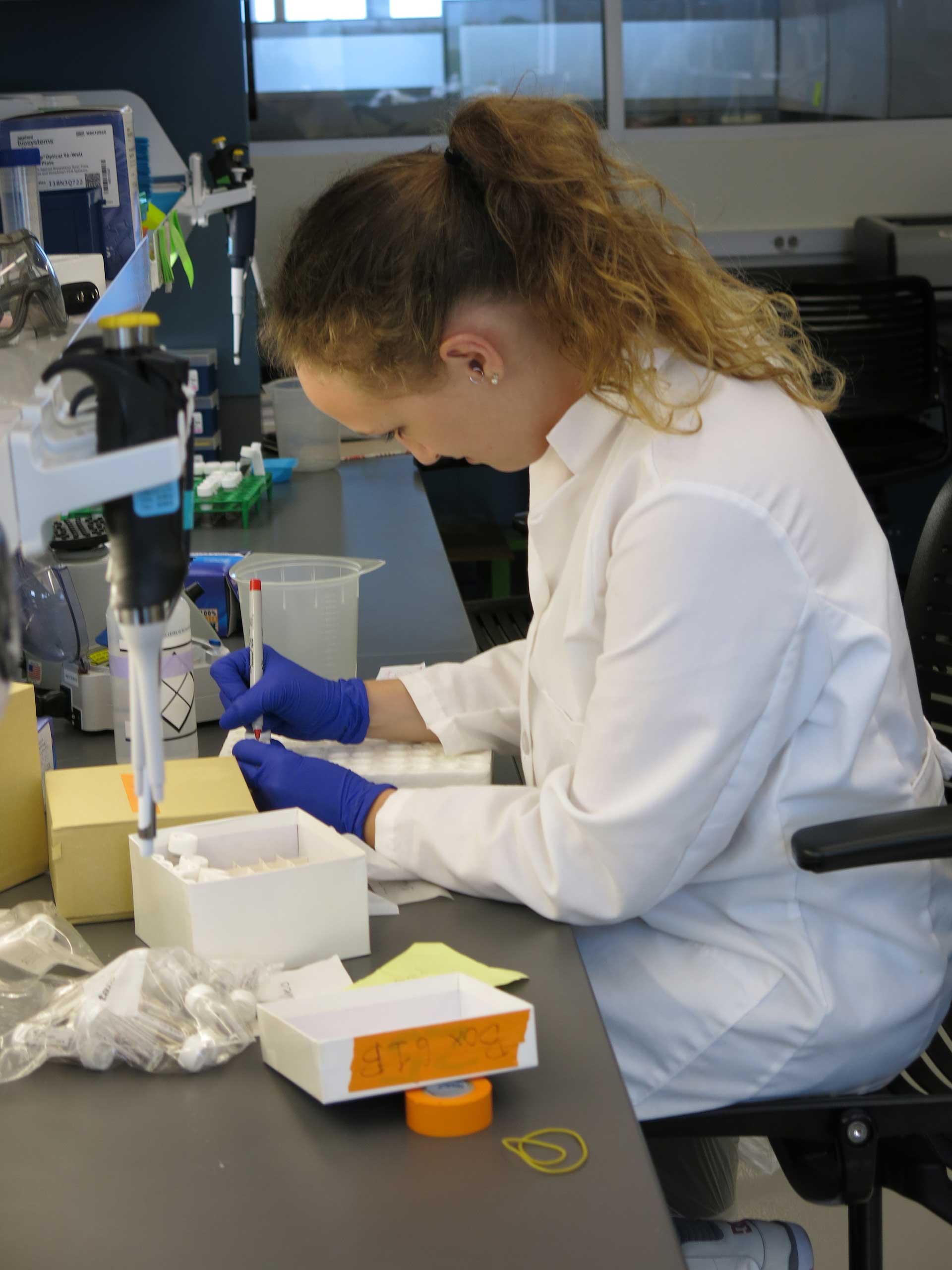
Cassandra conducting genetic lab work at the SOSSRC. Photo by Cristin Fitzpatrick | © Save Our Seas Foundation.
TFUI: What do you think needs to be done for future shark conservation?
CR: I think the one thing that is most critical to saving our sharks is a shift in public opinion. The stigma of fear surrounding sharks needs to be replaced by admiration and respect. That shift is only going to come from education and outreach. Fortunately, I do feel that that shift is already in motion!
Sharks have been around on this earth much longer than we have. They are at the top of the complex oceanic food web. As a species, we need to recognise that the ocean isn’t our swimming pool; it is the wilderness. We need to respect that we are not at the top of the food web when we step in the water. And we need to realise that our survival as a species depends a lot on the survival of sharks and the health of our oceans.
To quote the famed marine conservationist Sylvia Earle, ‘With every drop of water you drink, every breath you take, you’re connected to the sea.’ This is the message that needs to be spread. Our health and vitality are directly linked to the health and vitality of the oceans. And our oceans cannot remain healthy without healthy sharks to keep them in balance.
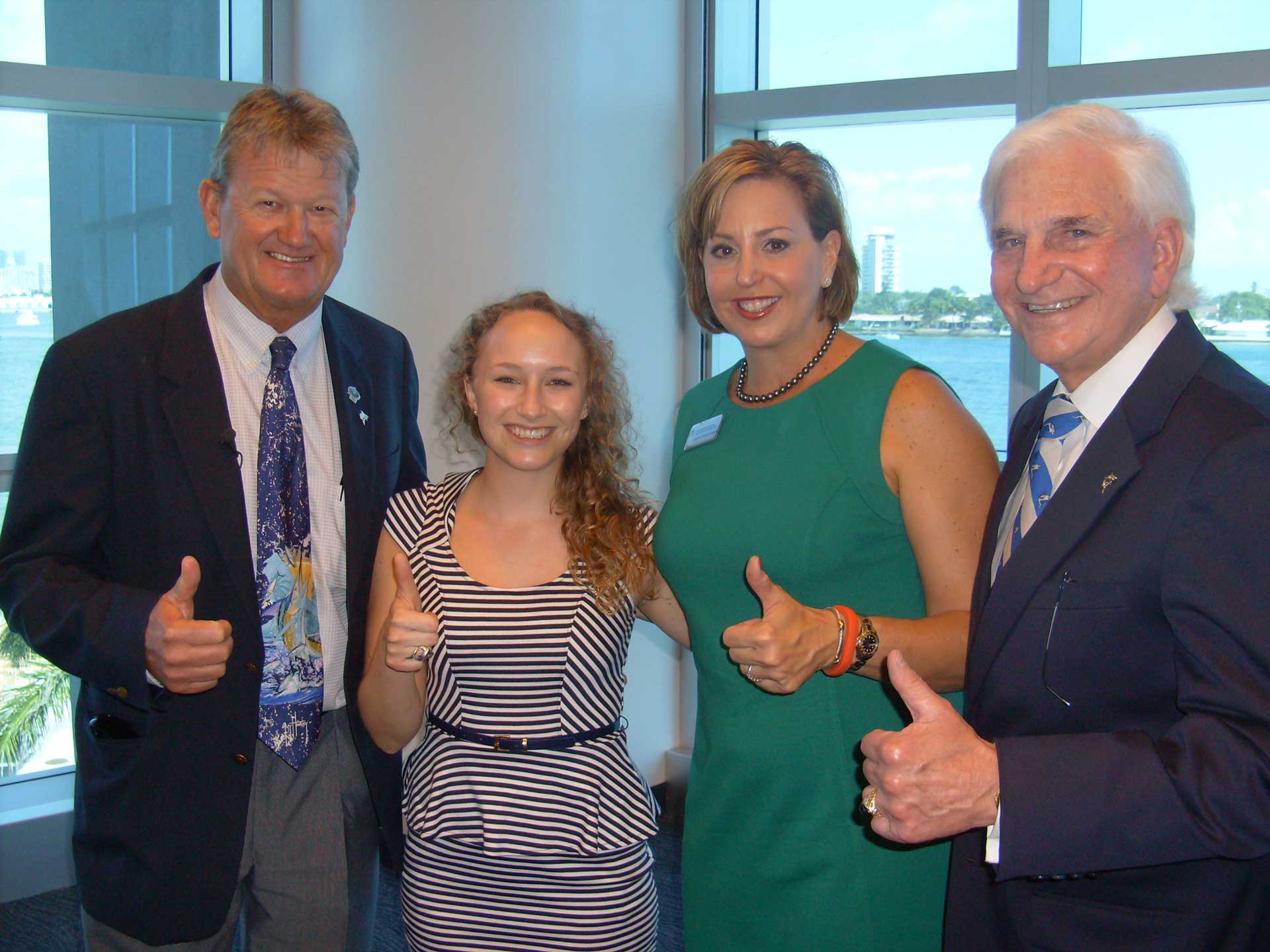
Cassandra with (from left to right) Dr. Guy Harvey, NSU’s Vice President of Advancement and Community Relations Dr. Jennifer O’Flannery Anderson, and NSU’s President and CEO Dr. George Hanbury after the naming ceremony of the Guy Harvey Oceanographic Center at NSU. Cassandra gave a speech about her passion for marine research and work with the SOSSRC and the Guy Harvey Research Institute. Photo © Nova Southeastern University.
TFUI: You were an intern at Oceans Research for four months. What did that experience teach you about yourself, your career path and, ultimately, the sharks?
CR: Working at Oceans Research was a life-changing experience. I will never forget the first time I saw a white shark during my first weekend in Mossel Bay, while cage diving with White Shark Africa. It was a 3.5-metre female. As soon as she came to the boat I was in my wet suit and ready to be one of the first group in the cage. She was incredible! She was so beautiful, so completely mesmerising.
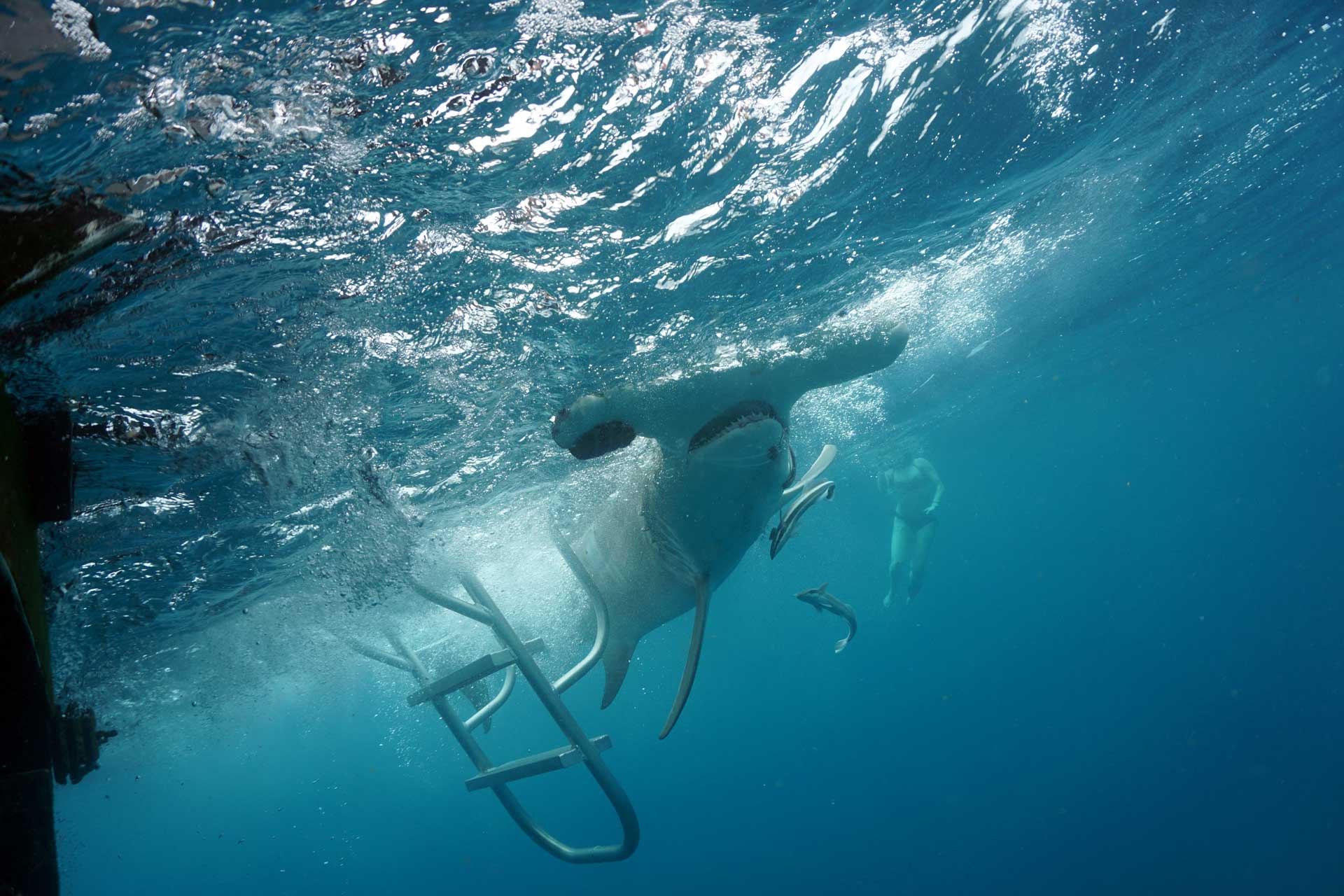
A great hammerhead shark caught in Dania Beach, FL by the Guy Harvey research Institute. Cassandra is swimming in the background.
TFUI: Oh, we can agree. Those sharks were a sight to see!
CR: It was awesome to experience that with you! I fell in love with the sea and its inhabitants over and over again every single day I was in Mossel Bay. The passion that I cultivated during my time there will stay with me forever. However, I think the most important thing I learned from working at Oceans Research was that I can do it. Do what, you may ask? I can fearlessly jump into a cage next to a 3.5-metre white shark. I can toss chum into the water (and even make a chum-bow – a rainbow of chum) for hours and get not even the least bit queasy. I can move quickly around a boat and effectively snap photos of dorsal fins. I can successfully keep extremely curious white sharks at bay with a tuna head on a rope. I can pull up and deploy an anchor repeatedly throughout the day. I can even catch a one-metre pyjama catshark with only my hands while free diving (don’t try that one at home, kids).
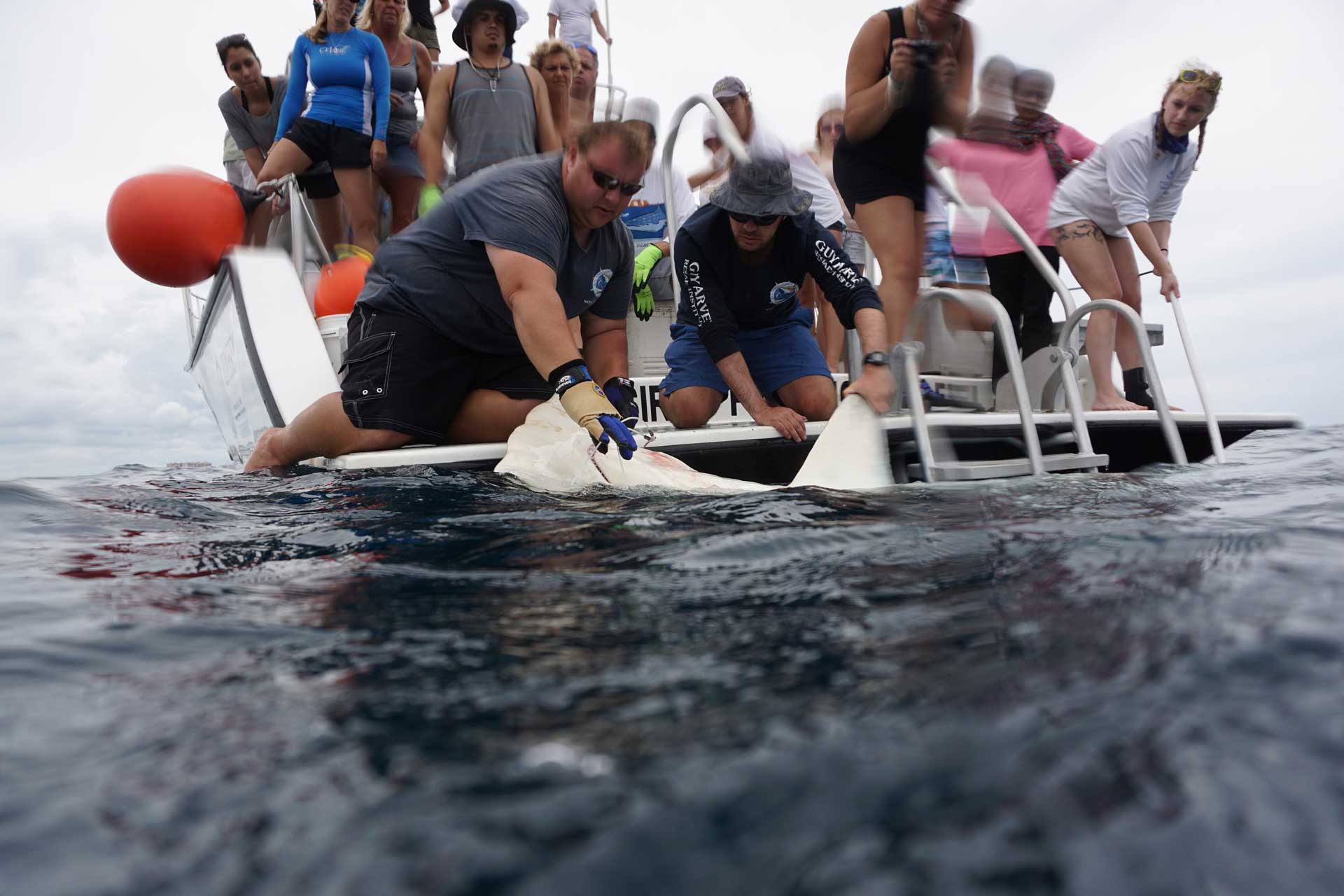
Cassandra works with Dr. Derek Burkholder and Dr. Jeremy Vaudo of the Guy Harvey Research Institute to secure the great hammerhead shark in Dania Beach, FL. Photo © Guy Harvey Research Institute.
TFUI: That’s a great message to get out to everyone, especially girls: you can do whatever it is you set your mind to.
CR: Exactly! As a vertically challenged female (I’m 5 foot 2 inches), I have faced a lot of doubt along my journey. Fortunately, I am so blessed to have two incredible parents who never tried to place limits on me and never doubted my ability to accomplish something I truly wanted to do. My time in South Africa taught me that I am 100% capable of doing anything I set my mind to, including excelling outside my comfort zone. I think the worst thing someone can do to someone else (or themselves) is to put them in a box. Guess what? If you want to do it, you can do it!
TFUI: Speaking about ‘doing it’, let’s talk about the worst experience in the field or lab you’ve had. What did you learn from it?
CR: Sometimes things don’t go according to plan. Machines stop working, glassware gets dropped, samples get mixed up, things fall in the ocean. Sometimes it’s your fault, sometimes it’s not. I don’t have a specific example to share, but I have definitely learnt important lessons when things go wrong. First and foremost, take a breath. Acknowledge if you made a mistake and accept fault. If something needs to be tended to immediately, take action. Then, if possible, walk away for a little bit. It’s much easier to tackle a problem or fix a mistake with a clear head. However, at the end of the day, you just do the best you can.

Cassandra prepares fish for drumlining with the Guy Harvey Research Institute in Dania Beach. FL. Photo © Guy Harvey Research Institute.
TFUI: That is a great mentality, Cassandra. Do you have any advice for those hoping to follow in your sharky footsteps?
CR: Going back to what I learnt in South Africa, my best advice is that you can do it! The path to becoming a scientist is far from glamorous. Most of my days are currently spent in the lab or behind a computer running analyses (sorry kids, maths is important!). But then again, I swam alongside a 10-foot great hammerhead a couple of months ago!
TFUI: No, no, don’t mind me. Not envious at all. [laughs]
CR: [laughs] Hey, now! You get to do some pretty cool stuff too. There’s that old cliché, ‘If you love what you do, you’ll never work a day in your life’. Well, I don’t totally agree with that. I love what I do, but I have worked my butt off to get to where I am today, and I continue to work my butt off. If you want to be a true scientist, you too will have to work hard. It doesn’t come for free and it’s not for the faint of heart.
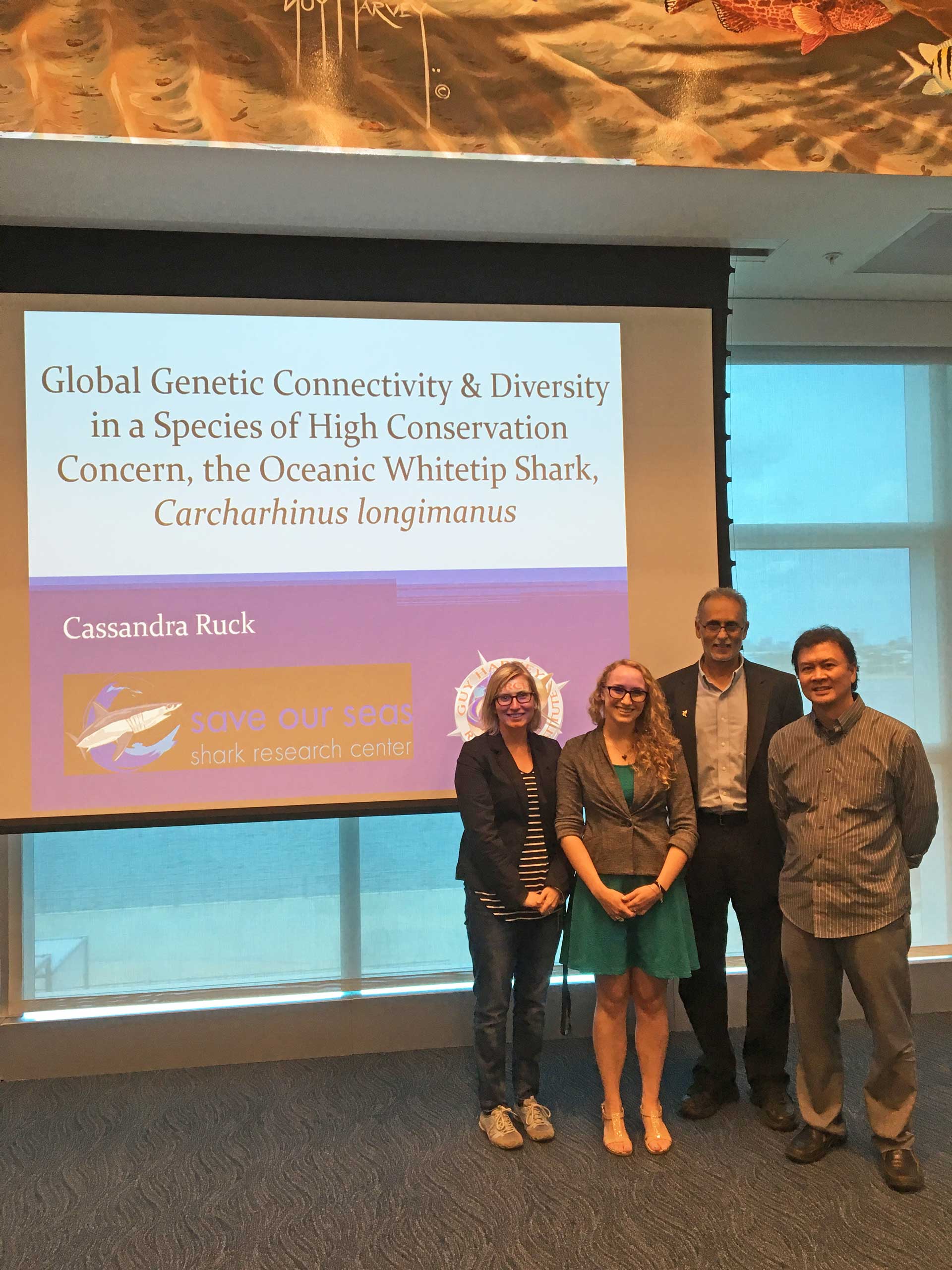
Cassandra following the defense of her Master's thesis with her committee members (from left to right): Dr. Andrea Bernard, Dr. Mahmood Shivji, Dr. Jose Lopez.
TFUI: That is something we at Sarasota Fins try to instil in our educational curriculums. Not every day will be rainbows and sharks breaching out of the ocean to corny sitcom music.
CR: That is definitely an important message to share, especially with kids who want to pursue a career in science. It’s not all chum-bows. [laughs] But I will be honest with you, all the work I have put into my education and career has been so worth it. I have learnt so much and the opportunities I have had to witness the true majesty of sharks and the ocean are invaluable. I have met incredible people and am excited about encounters, experiences and opportunities that will come my way in the future. Pursuing a career motivated by passion is far more rewarding (at least for me) than a career motivated purely by monetary gain. If you want to do this, you will work hard. But if you keep an open mind and a sense of adventure, the experiences you will come across will be 100% worth it.
So my advice? Work hard. If someone tells you that you can’t do it, turn around and show them that you can. Get your feet wet (literally). Accept challenges head on. Stick to your guns. Take opportunities when they present themselves. And hold on tight, you’re in for a wild ride!
TFUI: Thanks, Cassandra, for taking time to speak to us and for the motivational advice. It certainly kicks our butts into gear as we start our own MSc! Good luck, my friend.
CR: Good luck to you as well! You are going to do amazing things in New Zealand and beyond. And for those interested in my work and the work of my lab, check out the links above.’
You can read the original interview here.
